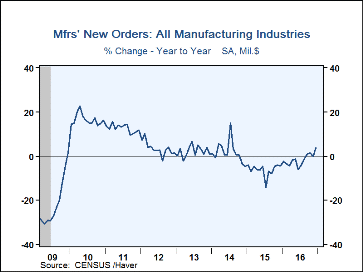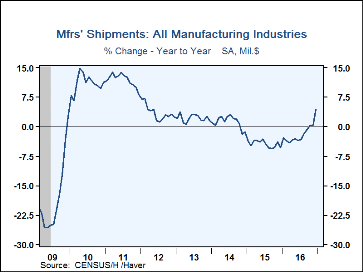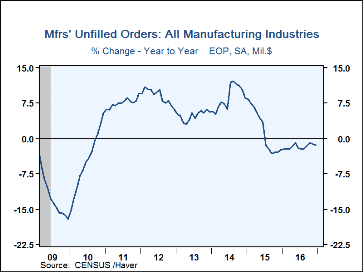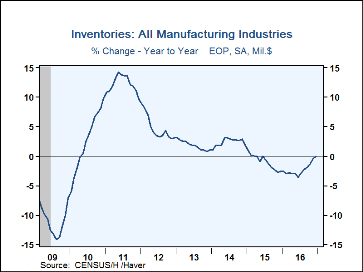 Global| Feb 06 2017
Global| Feb 06 2017U.S. Factory Orders Strength Led by Nondurables
by:Tom Moeller
|in:Economy in Brief
Summary
Manufacturing sector orders increased 1.3% during December (2.0% y/y) following a 2.3% November decline. Durable goods orders eased 0.5% (-0.7% y/y). Transportation sector orders fell 2.5% (-5.7% y/y) with a 64.0% plunge in defense [...]
Manufacturing sector orders increased 1.3% during December (2.0% y/y) following a 2.3% November decline. Durable goods orders eased 0.5% (-0.7% y/y). Transportation sector orders fell 2.5% (-5.7% y/y) with a 64.0% plunge in defense aircraft & parts orders. Orders excluding defense rose 2.4% (1.9% y/y) following a 3.2% drop. Orders outside of the transportation sector increased 2.1% (3.8% y/y) as bookings for computers & electronic products jumped 2.6% (4.7% y/y). Machinery orders improved 0.7% (5.3% y/y), but electrical equipment orders eased 0.6% (5.3% y/y) following strong gains in the prior two months. Nondurable goods orders (which equal shipments) jumped 3.1% (3.5% y/y).
The rise in nondurable goods shipments reflected a 15.3% surge (21.6% y/y) in petroleum refinery shipments. Basic chemical shipments gained 1.1% (2.3% y/y), and textile mill shipments rose 2.7% (6.6% y/y) after two months of strong gains. Food product shipments also were strong and posted a 1.1% rise (3.3% y/y). Paper product shipments gained 0.7% (1.1% y/y). Durable goods shipments improved 1.4% (3.1% y/y). Transportation equipment shipments jumped 2.4% (4.5% y/y) led by strength in the aircraft sector. Machinery shipments increased 1.6% (-2.2% y/y), and computer & electronic product shipments rose 0.8% (6.4% y/y).
Unfilled orders declined 0.6% (-1.7% y/y) continuing the weak trend of the last year. Transportation sector backlogs fell 1.1% (-3.1% y/y). Outside of the transportation sector, unfilled orders improved 0.4% (2.3% y/y). Electrical equipment & appliance backlogs increased 1.3% (10.4% y/y) after a 2.3% surge. Unfilled orders for computers & electronic products gained 0.7% (4.6% y/y), but machinery order backlogs ticked just 0.1% higher (-4.0% y/y).
Inventories in the factory sector edged just 0.1% higher in December (0.2% y/y) after a 0.5% gain. Outside of the transportation sector, inventories rose 0.2% (0.2% y/y). Durable goods inventories eased 0.1% (-1.1% y/y), but fabricated metals inventories fell 0.3% (-1.3% y/y), down for the fourth month in the last five. Machinery inventories increased 0.5% (-1.7% y/y), but inventories of computers & electronic products fell 0.3% (-0.2% y/y). Electrical equipment inventories remained unchanged (-1.5% y/y).
The factory sector figures are available in Haver's USECON database.
| Factory Sector- NAICS Classification (%) | Dec | Nov | Oct | Dec Y/Y | 2016 | 2015 | 2014 |
|---|---|---|---|---|---|---|---|
| New Orders | 1.3 | -2.3 | 2.8 | 2.0 | -1.4 | -6.3 | 1.8 |
| Shipments | 2.2 | 0.3 | 0.2 | 3.5 | -1.5 | -4.4 | 1.2 |
| Unfilled Orders | -0.6 | -0.2 | 0.8 | -1.7 | -1.7 | -2.4 | 8.8 |
| Inventories | 0.1 | 0.5 | 0.1 | 0.2 | 0.2 | -2.5 | 1.8 |
Tom Moeller
AuthorMore in Author Profile »Prior to joining Haver Analytics in 2000, Mr. Moeller worked as the Economist at Chancellor Capital Management from 1985 to 1999. There, he developed comprehensive economic forecasts and interpreted economic data for equity and fixed income portfolio managers. Also at Chancellor, Mr. Moeller worked as an equity analyst and was responsible for researching and rating companies in the economically sensitive automobile and housing industries for investment in Chancellor’s equity portfolio. Prior to joining Chancellor, Mr. Moeller was an Economist at Citibank from 1979 to 1984. He also analyzed pricing behavior in the metals industry for the Council on Wage and Price Stability in Washington, D.C. In 1999, Mr. Moeller received the award for most accurate forecast from the Forecasters' Club of New York. From 1990 to 1992 he was President of the New York Association for Business Economists. Mr. Moeller earned an M.B.A. in Finance from Fordham University, where he graduated in 1987. He holds a Bachelor of Arts in Economics from George Washington University.










